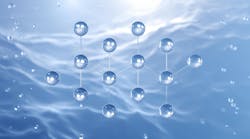The National Water Research Institute (NWRI) announced the publication of the third edition of the "Ultraviolet Disinfection Guidelines for Drinking Water and Water Reuse" at the IUVA 2012 Americas Conference.
These guidelines provide regulatory agencies and water and wastewater utilities across the country with a common basis for evaluating and implementing ultraviolet (UV) disinfection, which is a key technology used in the treatment of water. UV treatment can inactivate many waterborne pathogens, such as viruses, bacteria and parasites like cryptosporidium and giardia. Unlike chemically based disinfection options, UV disinfection does not produce potentially harmful disinfection byproducts during the water disinfection process.
The announcement was made by Jeff Mosher, executive director of NWRI, at the International Ultraviolet Association (IUVA) conference "Moving Forward: Sustainable UV Solutions to Meet Evolving Regulatory Challenges" being held Aug. 12 to 14 in the Washington, D.C., area.
"Because of its advantages," said Mosher, "demand for UV is growing, based in part on the use of recycled water to meet water supply needs. The UV Guidelines are the most commonly used reference by regulators, water and wastewater agencies, design engineers, and equipment manufacturers to ensure the efficacy of UV installations."
The revisions in the third edition of the UV guidelines reflect experience gained from the application of the guidelines over the years. Specifically, the "Protocols" section of the guidelines was updated to provide a standardized protocol for conducting "spot-check" performance MS-2 based viral bioassays to validate the installed performance of full-scale UV disinfection systems, and to standardize the assignment of UV dose when conducting MS-2 based viral assays by making use of a standard MS-2 dose-response relationship.
Key revisions include:
- · All reclamation systems must undergo commissioning tests that demonstrate disinfection performance is consistent with design intent.
- · Velocity profiles have been eliminated as an option for transferring pilot data to full-scale facility design.
- · On-site MS-2 based viral assays are used for both the validation and commissioning test.
- · A standard MS-2 dose-response curve is used to derive the reduction equivalent dose.
- · The design equation is based on the lower 75-percent prediction interval for reclamation systems. The lower 90-percent prediction interval is used for drinking water systems.
- · Commissioning tests will require seven out of eight on-site measurements exceeding the operational design equation.
- · The addition of an appendix to illustrate the computations involved in the application and evaluation of UV disinfection systems.
The UV Guidelines are available to download at www.nwri-usa.org/uvguidelines.htm.
Source: International Ultraviolet Assn.

